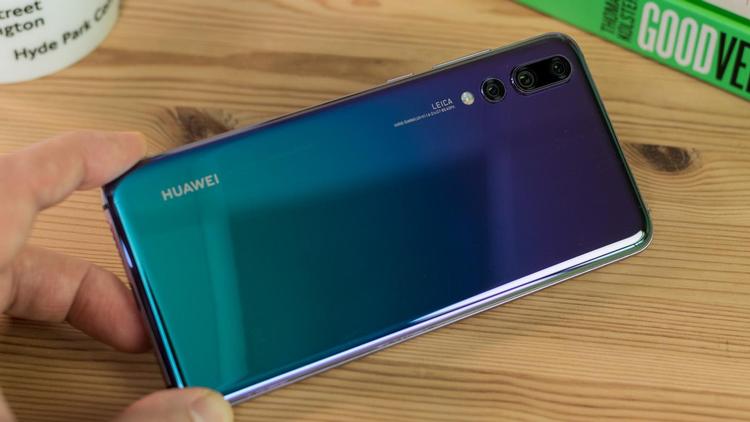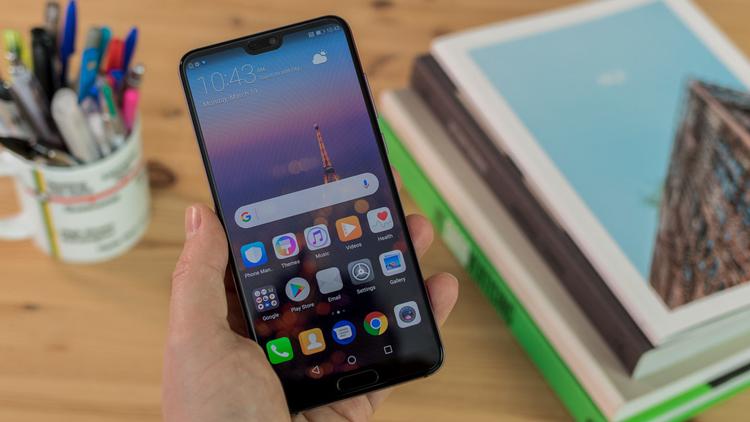It’s that latter phone we’re reviewing here, a beautiful-looking device with triple rear cameras that deliver arguably the best photos from any phone currently available. If you prefer, you can jump straight to the sample photos.
Price and availability
£799 SIM-free£70 cheaper than Galaxy S9+£200 cheaper than iPhone X
At the phone’s launch in Paris, Huawei announced that it costs €899. In the UK, you can buy a P20 Pro for £799 SIM-free from Carphone Warehouse. That’s a lot (the regular P20 is £599) but it’s the same price as the iPhone 8 Plus (£799/US$799) and cheaper than the Galaxy S9+ (£869/US$839). EE offers it for £39 per month with a £50 up-front cost (24-month contract). The P20 is cheaper, and you can read our separate review of that model, as well as our comparison of the P20 Pro and the iPhone XS.
Design and build
Glass front and rearUnique gradient colour options
The P20 is, just like the Mate 10, a redesign rather than an iteration of the P10. That’s one reason it’s called the P20 and not the P11. In any case, it has rounder edges than its predecessor but, more noticeably, a glass back. Without doubt it looks much better than the sandblasted aluminium of the P10 and comes in a range of colours including Twilight which is a gradient from teal to a purple hue. Photos can’t quite do the finish justice, but in the flesh it’s another eye-catching design that will make people ask “What phone have you got?”. If you prefer, there’s a black version, Pink Gold or Midnight Blue. The cameras stick out a bit, but once you put on a case that’s no longer a problem. The only disadvantage of a case is that it hides that mirror finish unless you go for a completely clear one. You might like to read the latest rumours about the P30 Pro.
Specs and features
IP67 water-resistantNo 3.5mm headphone jackFront-mounted fingerprint sensor
The other obvious feature that’ll get people talking is that third lens on the back. It’s the first phone to sport a trio of rear cameras, but it’s slightly odd that one sits separate to the other two. Amazingly, one has a 40Mp sensor, another has a 3x optical zoom lens and a black-and-white camera completes the triplet. Around the front, there’s a 6.1in screen which has a similar design to the iPhone X as there’s a camera and speaker in a notch at the top. It’s a smaller intrusion than Apple’s notch and you can choose in the display options to ‘hide’ it by putting a black strip across the top. The clock, battery level and notification icons remain in place, though, which maximises screen space and is a good compromise. Surprisingly, Huawei decided not to make the bottom edge bezel-less but instead cram a long, thin home button/fingerprint sensor there. It’s great news for those who despise rear-mounted fingerprint sensors. There’s IP67 water-resistance but all you’ll find on the bottom edge is a USB-C port, not a standard headphone socket.
Screen
With a resolution of 2244×1080, the 6.1in display is even wider than the Mate 10 Pro, with an aspect ratio of 18.7:9. Unlike the regular P20, the Pro gets an AMOLED screen. This offers more vibrant colours and a little more brightness. It isn’t the brightest screen around, but certainly bright enough. There are more options than on the the Mate 10 Pro. Like that phone you can enable the always-on option so the clock is displayed when the phone is asleep. But with the P20 Pro you can turn on a ‘Natural tone’ setting which changes the colour temperature according to the ambient light – exactly like the True Tone display on an iPhone or iPad. You can also choose vivid or natural colours, and even adjust the screen’s colour temperature manually if you want to. There’s the expected blue-light reduction for night-time use, but you can’t schedule this according to sunset and sunrise times, which would have been nice. Overall, this is a fabulous screen with excellent contrast, great colours and perfectly good pixel density. And unlike other OLED displays (think Pixel 2 XL) it doesn’t suffer a noticeable blue tint when viewed off-axis. There is a slight tint as you tilt the phone, but that’s true of every OLED screen, including the iPhone X.
Processor, memory and storage
The P20 borrows the Kirin 970 processor from the Mate 10, but that’s not really an issue since it’s a very fast chip. On the P20 Pro, it’s backed by 6GB of RAM and 128GB of on-board storage. No surprise, then, that performance is essentially the same as the Mate 10 – and P20 – which use the same CPU. And all are very quick indeed.
One thing you won’t find is a slot for adding extra storage via a microSD card. With 128GB already on board, you could argue that this isn’t really an issue, but it’s still a cross in a box that’s ticked by the Galaxy S9+.
Connectivity and audio
As you’d expect, there’s 802.11ac Wi-Fi with MIMO, but the older version of Bluetooth (4.2 not 5.0). This is a dual-SIM phone and supports Cat 18 LTE for up to 1.2Gb/s download speeds, when they’re available from your mobile operator that is. You get stereo speakers by virtue of the use of the earpiece at the top of the screen as well as another speaker in the bottom edge. Unfortunately, as with the Mate 10 Pro, the effect isn’t brilliant: the bottom speaker is much louder and has a much larger frequency range. This means you don’t get a nice even sound when watching videos. If that’s a priority, then consider the Pixel 2 XL or another phone with dual front-firing speakers.
Cameras
Cameras are of course the P20’s main attraction. They’re so important that the whole rear of the phone has been designed around the cameras, with the Huawei logo running parallel to the line of cameras so it’s readable when you’re taking a picture – or video – in landscape mode. The left-most camera in this orientation is the 20Mp mono camera that Huawei has used for quite a few of its recent phones, including the P10. In the middle is a 40Mp colour camera and, on the right, an 8Mp camera. The latter two work together to produce a 3x optical zoom. Those are some serious numbers, and you’ll probably recall Nokia putting a 41Mp sensor in its 2012 PureView 808 phone (and later using it in the Lumia 1020). Huawei says the only the 8Mp camera benefits from optical stabilisation, but iFixit’s teardown of the P20 Pro reveals that all three have the hardware in place. The company responded when asked to clarify this with the following: “We designed the P20 Pro to offer the best smartphone photography experience to consumers. The triple-camera system is meticulously designed as a complete, proprietary solution comprising hardware and software. AIS (AI image stabilization), as part of the solution, enables some truly exciting possibilities such as shooting clear photos in low-light conditions without a tripod. Details pertaining to how each component works are confidential, therefore we cannot comment further.” While you can shoot photos at 40Mp, the P20 Pro defaults to 10Mp. This is to enable a 5x Hybrid Zoom mode which combines the three cameras and some clever processing to deliver some credible-looking telephoto shots at 10Mp. Here’s how that looks in the real world. The images here have been resized in Photoshop, but we have included 100% crops of the 3x and 5x photos below so you can see the full level of detail captured. This is the 100% crop of the 3x photo: And here’s the same crop from the 5x hybrid photo: It’s certainly impressive, with the hybrid mode delivering sharper results than you might expect and better than simply interpolating a 3x photo in Photoshop to make it larger. Camera features don’t stop there. There’s a nifty six-second long exposure mode which uses AIS (Artificial Intelligence Stabilisation) and ISO right up to 51,200 to deliver sharp night shots without a tripod. The Kirin 970’s NPU (Neural Processing Unit) is used along with all the camera hardware to eliminate blurring caused by shaky hands. And while it sounds too good to be true, it actually works. We tried it in an almost pitch-black room with a cityscape projected in the background and, although we could only review the images on the phone’s screen, they certainly looked sharp enough. We even compared this mode to an equivalent 6-second long exposure in the Pro camera mode where we saw the expected blurry mess, so that AIS is clearly doing a lot. You can’t select anything above ISO 6400 manually though: the highest 102,400 ISO is only used when needed in the Night Shot mode. In our usual low-light comparison, the long-exposure shot has more saturated colours and is clearly sharper than the standard auto mode (click/tap to enlarge): On top of this, the Ultra Snapshot (where you double-press the volume down button to take a photo even if the phone is asleep) now takes just 0.3 seconds, so you can pick up your P20 Pro and capture whatever’s going on at that instant.
AI smarts
Continuing with the AI theme, the P20 Pro uses “4D predictive focus”. It analyses movement in the frame and predicts where the object will go next so – hopefully it’s in sharp focus no matter when you hit the shutter button. We tried this out on a couple of fencers and the phone picked one person and followed his movements. And for the most part, it accurately predicted the direction he would move next. Although the foils were blurry due to the fast movement, the fencer was in sharp focus. AI is also used, as it is on the Mate 10, for scene recognition. The P20 Pro can identify 19 different scenarios (6 more than the Mate 10) from food to pets to portraits and landscapes. This isn’t some gimmick: it makes the camera app a joy to use because all the settings are automatically adjusted in an instant so you get the best possible photo. And it works really well, quickly and accurately detecting scenes such as cats, food, flowers, foliage, people and more. Its only failure is that it boosts greenery to ridiculously lurid levels in the name of making it ‘lush’, the result being grass appears radioactive. Hopefully Huawei can tone this down in a software update. There are wins, though. If you point the camera at just one person with their head and shoulders in the frame, it will automatically switch to portrait mode and blur the background. Here’s the difference between a standard photo and one taken with portrait mode. It doesn’t perfectly mask out the background, but still does a nice job: Huawei refused to say if the new AI features would find their way onto the Mate 10. Here’s a comparison of the 40Mp and 10Mp modes. You can see that there’s very little processing done in the former, but in the latter there’s plenty of sharpening and also HDR. Yet all we did between taking the two photos was change the resolution. Here’s a 100% crop of the 40Mp photo: Around the front you’ll find a 24Mp selfie camera. That’s not a typo either: the P20 pulls no punches with its sensor resolutions. In our limited testing, it proved to be very impressive indeed, delivering the kind of sharp detail usually reserved for rear cameras. Huawei says this will step down in resolution as light deteriorates in order to maintain sharpness and reduce noise.
Video
Photography is well covered then, but video is appears to be a second-class citizen (just as with the P10 and Mate 10). Don’t get us wrong: the P20 Pro shoots decent quality video. However, if you want to stray from the default setting of 1080p at 30 frames per second you lose stabilisation. That means no stabilisation is offered at all at 1080p60 or at 4K. We asked Huawei to explain why this is the case and this was the response: “When developing the P20 Pro, we prioritized on the features we know the consumers use most. We have focused on offering a great user experience at 1080P resolution with our AI-powered stabilization technology. We know that some users will want to capture videos in 4K so we have also made sure this option is still available to those who want it.” So we still don’t know why the OIS and AI stabilisation isn’t used for 1080p60 or in 4K. And it is a real shame. With no support for recording HDR video either, the P20 Pro isn’t the best choice for those who like to use their phone to make home videos. One slight redeeming feature is that Huawei has added a Super Slow Motion mode which – like the Galaxy S9 – shoots a second or so of 960fps video at 720p. The implementation isn’t quite as intelligent: you have to press the button at the instant the action happens. So as with the Xperia XZ1, it’s a bit of a case of luck if you manage to capture the motion you wanted. It processes the video for a few seconds afterwards so you can’t immediately shoot another clip, but the resulting video starts at normal speed, smoothly transitions to super-slo-mo and then back to normal speed at the end.
Battery
Despite the thickness of 7.8mm, there’s a 4000mAh battery in the P20 Pro. As with the long-lasting Mate 10 Pro, the P20 Pro will easily cope with a day of heavy use. And if you’re not too demanding, you’ll probably find it will last two days before needing a recharge. At worst, Huawei bundles a SuperCharge charger in the box, which will restore 60 percent in just 30 minutes, 80 percent in 45 minutes and a full charge in just under 90 minutes. And given that 60 percent will get you through a full day with the P20 Pro, that’s remarkable.
Software and apps
In the box, the P20 Pro ships with Android Oreo 8.1 and Huawei’s EMUI 8.1 software. If you already know Huawei phones and EMUI, you’ll know exactly what to expect: little has changed compared to the Mate 10 or P10. It defaults to an app grid like iOS, but you can enable the app drawer if you prefer not to have all your apps plastered across multiple home screens. There are a couple of improvements. One is that AI is used to tag photos for better searching. It can put photos into one of roughly 100 categories. It’ll also use algorithms to ‘score’ photos for aesthetic beauty so you can easily see the ‘best’ photos you’ve taken. AI can also straighten wonky horizons. If the notch bugs you, just choose the ‘Hide notch’ option in the settings and it disappears: EMUI 8.1 brings wireless file transfers to a PC or Mac with no special software required. We couldn’t test this out, though, and Huawei didn’t go into detail about exactly how this works. Similarly, the Huawei Clone app runs faster and can transfer data from your old phone up to 5x faster: 32GB of data can be “cloned” in 19 minutes according to the firm. The wide screen lends itself to multiple apps and sure enough, you can run certain apps side by side (or one above the other):
Related stories for further reading
Best phone deals Best SIM-only deals Best phone network All smartphone reviews Best smartphones How we test smartphones Best new phones coming soon
Jim has been testing and reviewing products for over 20 years. His main beats include VPN services and antivirus. He also covers smart home tech, mesh Wi-Fi and electric bikes.

















